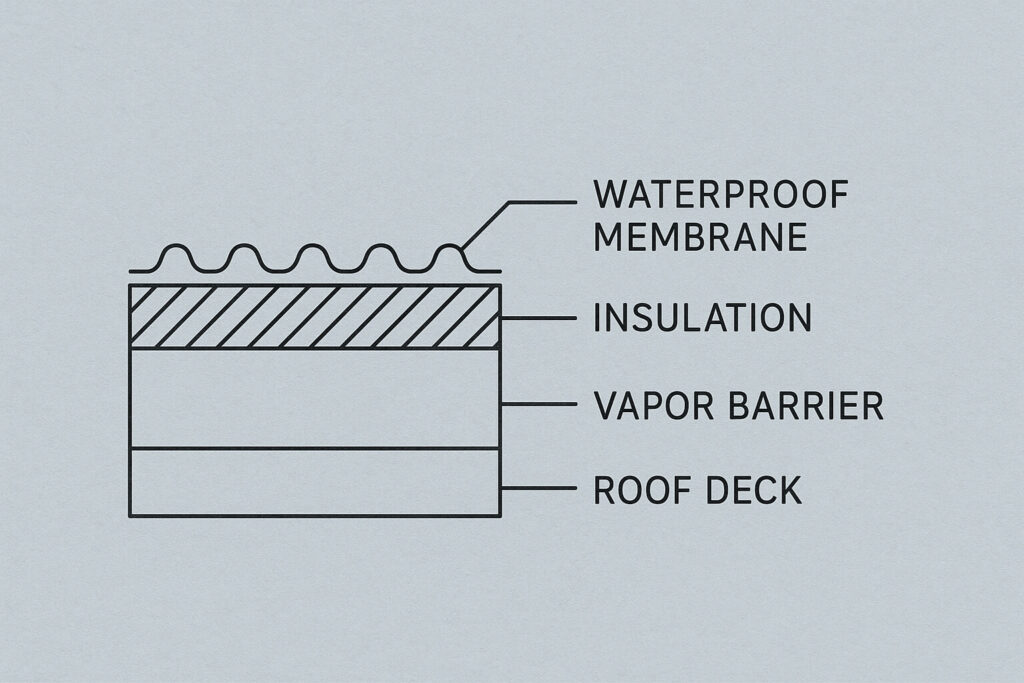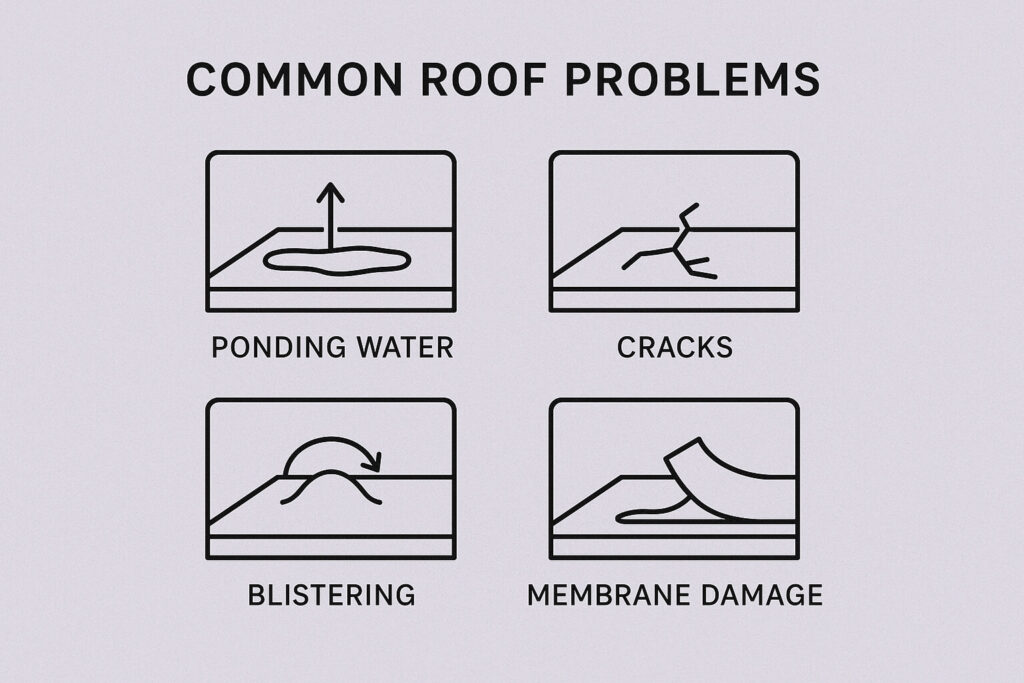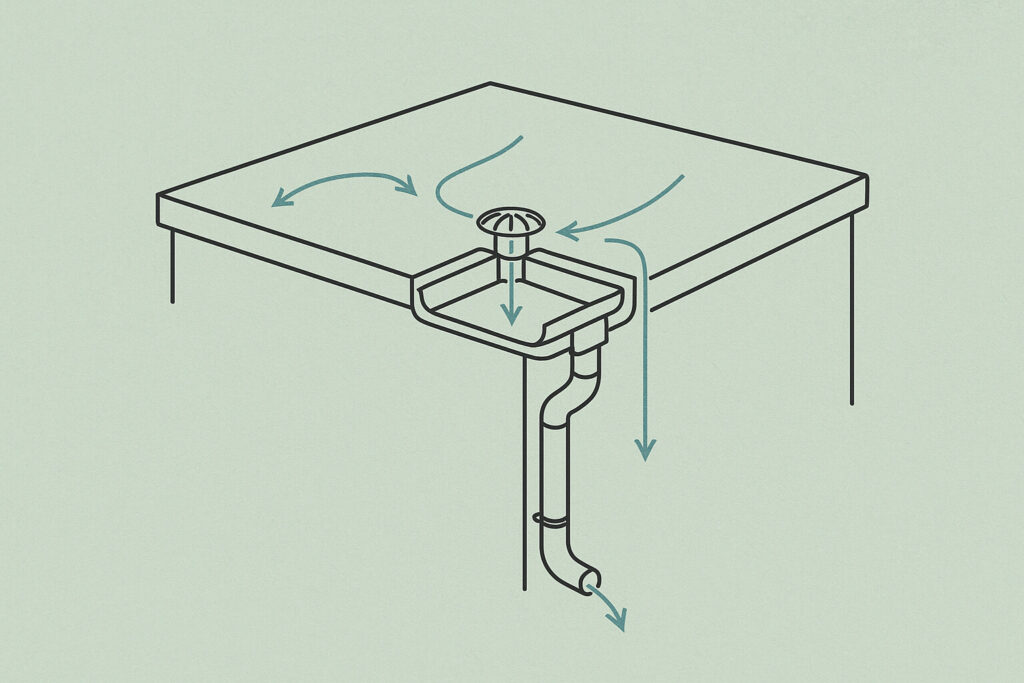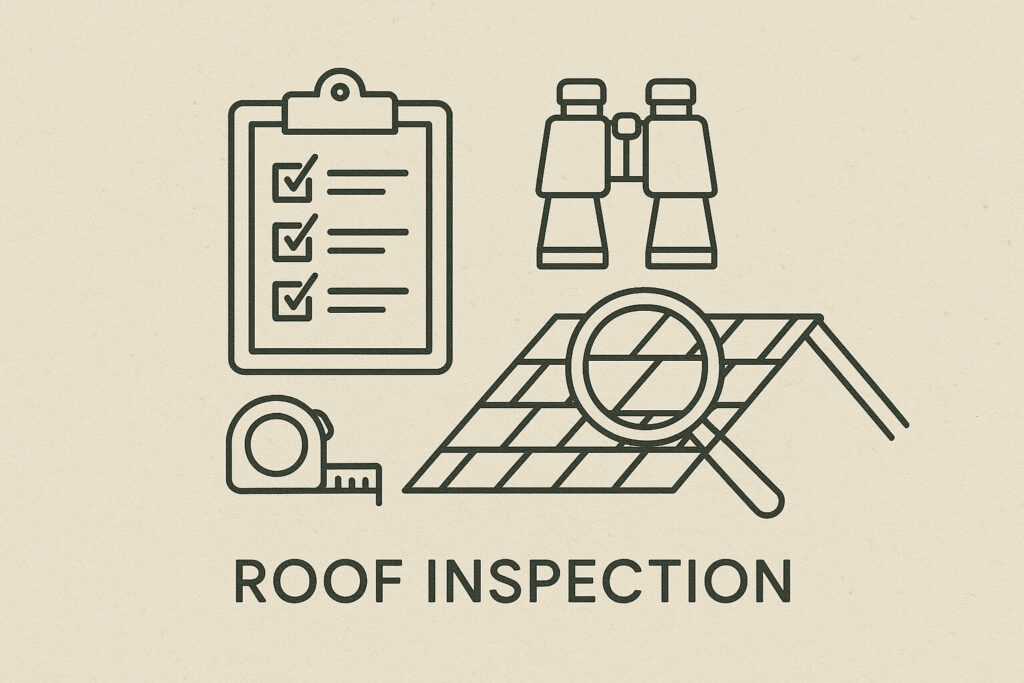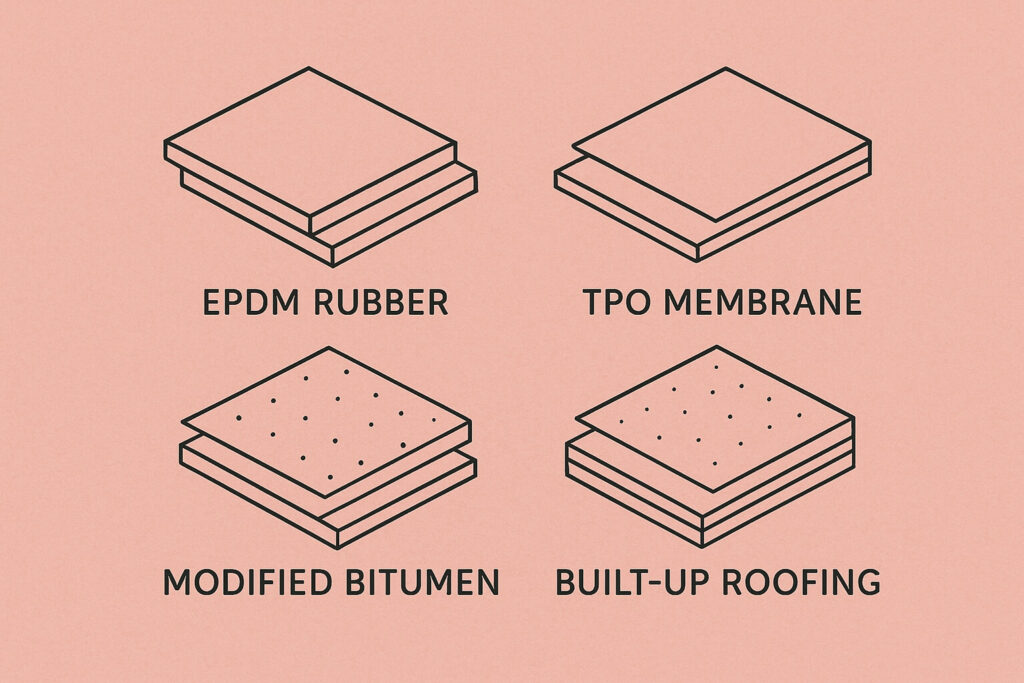Understanding Roof Insulation for Flat Roofs
Proper insulation is critical for flat roof performance in Bristol’s variable climate, yet it’s often overlooked or incorrectly installed. At Flat Roof Repair Bristol, we see insulation issues contributing to 60% of the flat roof problems we repair. This comprehensive guide explains the different insulation options, correct installation methods, and Bristol-specific considerations to ensure your flat roof performs optimally throughout the year.
Why Flat Roof Insulation Matters in Bristol
Flat roof insulation serves multiple critical functions beyond just thermal performance:
Thermal Efficiency
Bristol’s climate features mild winters and increasingly warm summers, making year-round thermal performance essential. Proper insulation reduces heat loss in winter and heat gain in summer, lowering energy costs throughout the year.
Technical insight: Building Regulations Part L 2021 requires a U-value of 0.25 W/m²K or better for flat roofs—equivalent to approximately 150-180mm of high-performance insulation.
Condensation Prevention
Interstitial condensation (moisture buildup within the roof structure) is a major concern in Bristol’s humid coastal environment. Correct insulation placement and vapour control layers prevent warm, moist indoor air from contacting cold surfaces within the roof build-up.
Structural Protection
Insulation protects the roof deck from extreme temperature fluctuations that cause expansion and contraction. In Bristol’s variable climate, this reduces stress on structural components and extends roof lifespan.
Acoustic Performance
Quality insulation reduces noise transmission from rain impact—a notable benefit during Bristol’s frequent rainfall periods.
Types of Flat Roof Insulation Materials
PIR (Polyisocyanurate) Insulation
Technical specifications: Rigid foam board with aluminium foil facings
Thermal conductivity: 0.022-0.028 W/mK
Thickness options: 25mm to 150mm
Key advantages:
- Excellent thermal performance in minimal thickness
- Moisture resistant with foil facings
- Good compressive strength for foot traffic
- Fire resistant properties
Bristol recommendation: Our top choice for most residential applications due to superior performance in minimal space.
Mineral Wool Insulation
Technical specifications: Fibrous material made from volcanic rock or slag
Thermal conductivity: 0.032-0.044 W/mK
Thickness options: 50mm to 200mm
Key advantages:
- Excellent fire resistance
- Vapor permeable (reduces condensation risk)
- Good acoustic performance
- More environmentally friendly production process
Bristol recommendation: Ideal for properties where fire resistance is paramount or where vapour permeability is beneficial.
EPS (Expanded Polystyrene)
Technical specifications: Rigid foam made from expanded polystyrene beads
Thermal conductivity: 0.030-0.040 W/mK
Thickness options: 25mm to 200mm
Key advantages:
- Cost-effective solution
- Moisture resistant
- Good compressive strength
- Lightweight
Bristol recommendation: Suitable for budget-conscious projects where space isn’t constrained.
Tapered Insulation Systems
Technical specifications: PIR or EPS boards manufactured with built-in slope
Slope options: 1:40, 1:60, 1:80
Key advantages:
- Creates positive drainage across entire roof surface
- Eliminates low spots where water can accumulate
- Maintains consistent thermal performance
- Essential for flat roofs in Bristol’s rainy climate
Bristol recommendation: Critical for all new installations and recommended for replacements where drainage issues exist.
Insulation Placement: Cold Roof vs. Warm Roof
The position of insulation within the roof structure significantly impacts performance:
Cold Roof Insulation Placement
Insulation installed below the roof deck, typically between ceiling joists:
- Requires ventilation space above insulation
- Higher risk of condensation in Bristol’s humid climate
- Less energy efficient due to thermal bridging at junctions
- Generally less expensive to install initially
Common issues: We frequently find cold roofs with insufficient ventilation or missing vapour control layers—leading to condensation problems we address during our professional inspections.
Warm Roof Insulation Placement
Insulation installed above the roof deck but below the waterproofing membrane:
- No ventilation required (eliminates condensation risk)
- Superior thermal performance with no cold bridges
- Protects roof structure from temperature extremes
- Higher initial cost but better long-term value
Technical requirement: Must include a vapour control layer on the warm side of the insulation to prevent moisture migration.
Bristol-Specific Insulation Considerations
Coastal Climate Adaptation
Properties in coastal areas like Sea Mills require special considerations:
- Use insulation with moisture-resistant facings to combat salt air exposure
- Ensure complete vapour control to prevent salt-laden moisture penetration
- Consider additional thickness to compensate for increased thermal demands
- Verify compatibility with coastal roofing membranes like EPDM
Urban Heat Island Effect
Bristol’s urban areas experience higher temperatures than surrounding countryside:
- Increase insulation thickness in city centre properties
- Consider reflective roof membranes to reduce heat absorption
- Ensure adequate ventilation in roof spaces where applicable
- Address thermal bridging at roof edges more rigorously
Historic Building Requirements
For listed buildings or properties in conservation areas:
- Work with conservation officers to determine acceptable solutions
- Consider vapour-permeable options for traditional structures
- Balance energy efficiency with building breathability
- Document all changes for future reference
Calculating Required Insulation Thickness for Bristol
Determining the right insulation thickness involves several factors:
Building Regulations Compliance
Current Building Regulations Part L 2021 requires:
- U-value of 0.25 W/m²K or better for refurbishments
- U-value of 0.15 W/m²K or better for new builds
These translate to approximate thicknesses:
- PIR: 120-150mm for refurbishments, 180-220mm for new builds
- Mineral wool: 150-180mm for refurbishments, 220-250mm for new builds
- EPS: 140-170mm for refurbishments, 200-240mm for new builds
Practical Installation Considerations
While meeting regulatory requirements is essential, practical constraints often influence final thickness:
- Available space for insulation (particularly important in conversions)
- Structural capacity to support additional weight
- Drainage requirements (thicker insulation may require tapered systems)
- Cost-benefit analysis of incremental thermal improvements
Our experience shows that slightly exceeding minimum requirements often provides better long-term value through reduced energy costs.
Common Insulation Mistakes
Our repair work consistently reveals these preventable errors:
Inadequate Vapour Control
Missing or improperly installed vapour control layers allow moisture to penetrate the insulation, leading to:
- Reduced thermal performance (wet insulation loses up to 90% effectiveness)
- Timber decay in roof structures
- Intermittent leaks that are difficult to trace
Solution: Install continuous vapour control layer on the warm side of insulation with proper sealing at all junctions.
Thermal Bridging at Roof Edges
Insufficient insulation at parapet walls and eaves creates significant heat loss pathways:
- Accounts for 10-15% of total heat loss in poorly detailed roofs
- Creates cold spots where condensation forms
- Reduces overall thermal efficiency despite adequate main roof insulation
Solution: Use specialised edge insulation details and continuous insulation at all perimeter points.
Compression of Insulation
Insulation compressed during installation loses thermal effectiveness:
- Each 1% compression reduces thermal performance by approximately 1.5%
- Common at pipe penetrations and around rooflights
- Often occurs when insulation is cut too large for cavities
Solution: Cut insulation to precise dimensions and avoid over-tight fitting.
Insulation Upgrades and Retrofits
Improving existing flat roof insulation can be highly beneficial:
Adding Insulation Over Existing Roof
For existing flat roofs with adequate structural capacity:
- Install new insulation over existing membrane
- Apply new waterproofing membrane
- Maintains existing roof drainage profile
- Cost-effective solution for many Bristol properties
Consideration: Increases roof height, which may affect door thresholds and drainage.
Converting Cold Roof to Warm Roof
Replacing a problematic cold roof with a warm roof system:
- Remove existing roof covering
- Install new insulation above deck
- Apply new waterproofing membrane
- Ensure proper drainage design
This conversion effectively addresses many of the condensation issues common in cold roofs, particularly in Bristol’s humid climate.
Professional Installation: Ensuring Optimal Performance
Proper installation is as important as material selection:
- Seamless insulation layer with staggered joints
- Continuous vapour control with proper sealing
- Adequate drainage slope maintained throughout
- Thermal bridging minimised at all details
- Compatibility with chosen waterproofing system
At Flat Roof Repair Bristol, we specialise in flat roof insulation systems designed specifically for Bristol’s climate challenges. Our team ensures proper installation that meets Building Regulations while addressing the unique conditions of your property.
Investing in proper flat roof insulation delivers multiple benefits for Bristol property owners: improved energy efficiency, reduced condensation risk, extended roof lifespan, and enhanced comfort throughout the year. When combined with quality waterproofing systems like EPDM, proper insulation creates a high-performance flat roof that withstands Bristol’s challenging climate for decades. Schedule a professional assessment with our insulation specialists to determine the optimal solution for your Bristol property.
